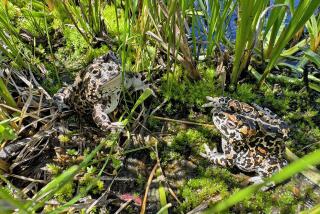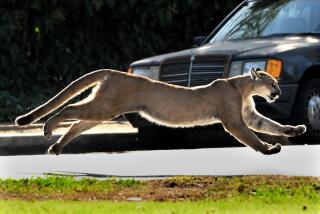Existence of rare red fox confirmed
The genetic signature of canine slobber on a bait bag of chicken scraps and a fuzzy photograph from a motion-sensitive camera north of Yosemite National Park have confirmed the existence of a red fox, thought to have been all but wiped out, the U.S. Forest Service announced last week.
“The last known sighting of a Sierra Nevada red fox in the Sonora Pass area was some time in the 1920s,” said Mike Crawley, Bridgeport District ranger. “Needless to say, we are quite surprised and excited by this find.”
Federal wildlife technicians Emily Crowe and Julien Pellegrini were checking hundreds of photos when they came across an overexposed image taken at 2:17 a.m. Aug. 11 of what appeared to be the rare red fox — with its characteristic white-tipped tail — trying to get at the bait bag dangling from a tree.
The Sierra Nevada red fox (Vulpes vulpes necator) lives at high elevations, eating small mammals and birds. It has a reddish head, back and sides; black backs of the ears; black “socks” on its feet; and a white-tipped tail.
But the only known population of the fox is roughly 20 animals clinging to survival in the Lassen Peak region, about 150 miles to the north.
DNA analysis of saliva from the tooth punctures on the bait bag allowed UC Davis wildlife genetics researchers Ben Sacks and Mark Statham to make a positive identification.
“We got back to the Forest Service and said, ‘Yep, you’ve got yourself a Sierra Nevada red fox there, and it’s distinct from the Lassen Peak population,’” Sacks said. “It’s got a genetic signature that we haven’t seen outside of the skulls and skins of museum specimens collected before 1926.
“Red foxes don’t live to be 100 years old, so we’re assuming there are more of them up there,” Sacks added. “So we now have two small, isolated populations, and we don’t know how big the second group is. That’s about as endangered as you can get.”
On Friday, federal biologists, UC Davis genetics researchers and university students began setting up additional monitoring stations and cameras to try to determine the size and health of the Sonora Pass population.
It remains to be seen whether the discovery will affect ongoing U.S. Marine Corps training exercises as well as plans to develop a snowmobile crossing in the remote area.
“It is very unusual to discover a new large animal species,” said Forest Service spokeswoman Christie Kalkowski. “In this case, it was like finding a rare jewel in a totally unexpected place.”
louis.sahagun@latimes.com
More to Read
Sign up for Essential California
The most important California stories and recommendations in your inbox every morning.
You may occasionally receive promotional content from the Los Angeles Times.











